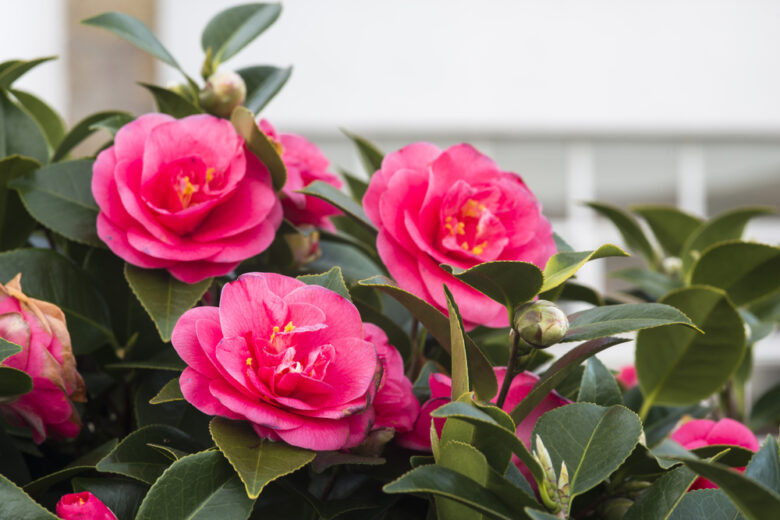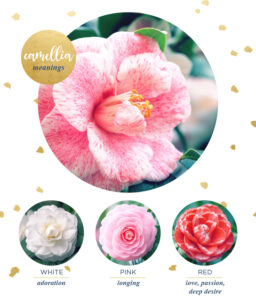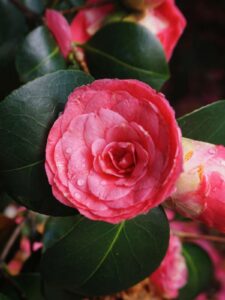Welcome to the enchanting world of camellias, where beauty, history, and magic intertwine to create a timeless charm. These delicate flowers have held a special place in human culture for centuries, captivating us with their vibrant colors and alluring fragrance. In this article, we will explore the fascinating influence and legends surrounding camellias, and why you should discover their timeless charm for yourself.
The History of Camellias
Camellias have a rich history that spans centuries. Originating in China and introduced to Europe in the 18th century, these beautiful flowers quickly gained popularity and became a symbol of love and beauty. Throughout the years, camellias have been featured in art, literature, and have even played a role in historical events. Today, they are still cherished for their elegance and timeless charm, making their history a fascinating journey that showcases their enduring appeal and cultural significance.
Where Did Camellias Originate From?
Camellias originated from East Asia, specifically from China and Japan. These countries have a rich history and a long tradition of cultivating camellias. The Chinese were the first to recognize the beauty and medicinal properties of camellias and began cultivating them. Later, camellias were introduced to Japan, where they became highly revered and an integral part of their culture. Through trade and exploration, camellias eventually spread around the world. Today, they are popular globally for their timeless beauty and symbolism. The origins of camellias are crucial in understanding their cultural significance and widespread appeal.
How Did Camellias Spread Around the World?
Camellias spread around the world through various means, including trade, exploration, and cultural exchange. Here are the steps in which camellias expanded globally:
- Origins in East Asia: Camellias originated in East Asia, particularly in China and Japan.
- Exploration and Trade: Through exploration and trade routes, camellias were introduced to other parts of Asia, such as Korea and Vietnam.
- European Discovery: European explorers, like Jesuit missionaries, encountered camellias during their travels in Asia and brought them back to Europe.
- Colonial Expansion: During the colonial era, camellias were further spread to regions like India and parts of Africa, where European powers established colonies.
- Garden Cultivation: Once introduced to new regions, camellias were cultivated in botanical gardens and private estates, allowing them to become popular ornamental plants.
These steps highlight the global journey of camellias, showcasing their spread and integration into different cultures around the world.
The Influence of Camellias in Different Cultures
Throughout history, the delicate and elegant camellia flower has captured the hearts of people from various cultures. In this section, we will delve into the rich influence of camellias in different cultures and how they have been revered and celebrated. From the ancient traditions of China to the refined aesthetics of Japan, and even to the romantic associations in European culture, the beauty and symbolism of camellias have left a lasting impact. Let’s explore the unique significance and legends surrounding camellias in these diverse cultures.
Camellias in Chinese Culture
In Chinese culture, camellias hold great cultural significance. They are seen as symbols of love, affection, and admiration. In ancient China, these flowers were associated with purity and nobility, often used to represent the beauty of women. Additionally, camellias were also utilized in traditional Chinese medicine for their healing properties. Today, they continue to be highly revered and are often chosen for Chinese weddings and other important events.
The delicate beauty and deep symbolism of camellias make them an integral part of the floral heritage in Chinese culture. The rich history of camellias in Chinese culture showcases the enduring charm and enduring significance of these exquisite flowers.
Camellias in Japanese Culture
In Japanese culture, camellias hold a significant place, symbolizing love, purity, and gratitude. Known as “Tsubaki,” camellias are highly revered and often featured in traditional tea ceremonies, where their beauty is admired. They also play a role in Japanese literature and art, appearing in paintings, poetry, and even kimono designs. The Japanese have also cultivated many unique varieties of camellias, showcasing their deep appreciation for these flowers. As camellias bloom during winter, their seasonal aspect is also significant in Japanese culture. Additionally, different colors hold different meanings, such as red symbolizing love and white representing purity. Camellias are also commonly used in Japanese weddings and traditional festivals. Throughout history, camellias have inspired Japanese artists and craftsmen, further emphasizing their elegance, beauty, and the fleeting nature of life. Overall, camellias have a multifaceted presence in Japanese culture, making them a beloved and cherished flower.
Camellias in European Culture
Throughout history, camellias have had a significant impact on European culture. European botanists and horticulturists were captivated by the beauty of camellias and played a crucial role in introducing and cultivating them in Europe. The flower’s elegance and charm made it a favorite among European nobility, becoming a symbol of love and admiration. Camellias were often featured in European gardens, paintings, and literature, and they continue to be cherished in European culture today, with countries like France and Italy hosting camellia festivals and exhibitions.
A heartwarming example of the lasting allure of camellias in European culture is the story of an English woman who dedicated her life to growing and preserving rare camellia varieties in her garden. Her passion for camellias inspired many others to appreciate and cultivate these remarkable flowers.
The Legends and Symbolism of Camellias
Camellias have captured the hearts and minds of people for centuries, with their delicate beauty and alluring fragrance. But beyond their physical allure, camellias also hold a rich history of legends and symbolism. In this section, we will delve into the enchanting legend of the white camellia and the powerful symbolism of camellias in different cultures around the world. Join us on this journey as we unravel the mystical and timeless charm of camellias in history.
The Legend of the White Camellia
The captivating legend of the White Camellia has been passed down through generations. According to the story, a young woman named Camellia fell deeply in love with a nobleman, but their love was forbidden. Heartbroken, Camellia transformed into a beautiful white flower, symbolizing purity and eternal love. This legend has been cherished in various cultures, including Chinese, Japanese, and European. The White Camellia remains significant in modern times, representing love, devotion, and resilience. Its timeless charm and symbolic meaning make it a beloved flower in gardens, weddings, and art.
The Symbolism of Camellias in Different Cultures
Camellias hold great symbolism in various cultures, representing love, purity, and longevity. In Chinese culture, camellias symbolize admiration and perfection, often given as gifts to express love and admiration. In Japanese culture, camellias represent purity and the divine, with white camellias being associated with death. In European culture, camellias are often seen as a symbol of love and gratitude. The universal appeal and enduring significance of camellias throughout history are showcased by their symbolism in different cultures. Their beauty and symbolic meaning have made camellias a cherished flower in various traditions around the world.
The Timeless Charm of Camellias
For centuries, camellias have captured the hearts of people with their timeless charm. These elegant flowers, with their exquisite blooms and lush green foliage, evoke a sense of beauty and grace that has been admired since ancient times. From China to Europe, camellias have been revered for their delicate petals and enchanting fragrance. Today, they are still beloved for their versatility, as they can be used in floral arrangements, gardens, and even as a source of tea.
The timeless charm of camellias cannot be denied, making them a top choice for any flower enthusiast.
Why Are Camellias Still Popular Today?
Camellias remain a beloved choice today due to their timeless charm and versatility. With their exquisite and diverse blooms, camellias are a top pick for gardens, bouquets, and floral arrangements. Their extended blooming season and adaptability to various climates make them a reliable option for gardeners. Additionally, camellias hold cultural significance in Chinese, Japanese, and European cultures, adding to their enduring popularity. The legends and symbolism surrounding camellias only add to their allure. Whether used in traditional ceremonies or modern floral designs, camellias continue to enchant people with their beauty and cultural importance.
How Are Camellias Used in Modern Times?
Camellias continue to be widely used in modern times for a variety of purposes.
- Ornamental Plant: Camellias are commonly grown as ornamental plants in gardens, parks, and landscapes.
- Floral Arrangements: The beautiful blooms of camellias are frequently incorporated into floral arrangements for special occasions and events.
- Tea Production: Camellia sinensis, a variety of camellia, is utilized in the production of different types of tea, such as green tea, black tea, and oolong tea.
- Cosmetics and Skincare: Extracts from camellias are often used in the production of cosmetics and skincare products due to their moisturizing and nourishing properties.
Additionally, camellias are also utilized in perfumes, as natural dyes, and even in culinary applications. Their versatility and timeless beauty make them a beloved flower in modern times.
What Makes Camellias a Timeless Flower?
The beauty, versatility, and symbolism of camellias have stood the test of time, captivating people across cultures for centuries. Their elegant and delicate blooms have inspired various forms of art, literature, and gardens, making them a truly timeless flower. Camellias are not only used for ornamental purposes in modern times, but also as symbols of love and devotion, and even as ingredients in skincare products. Their resilience and enduring appeal continue to bring joy to people throughout history and in present times, making camellias a truly timeless flower.
Frequently Asked Questions
What historical figures were known for their love of camellias?
Throughout history, many prominent figures have been known for their love of camellias. These include Napoleon Bonaparte, Marie Antoinette, and Coco Chanel.
What influence did camellias have in ancient civilizations?
In ancient China, camellias were considered to be a symbol of wealth and prestige, and were often used as gifts to show appreciation and honor. In Japan, they were seen as a symbol of perfection and were often featured in art and literature.
Are there any legends or myths associated with camellias?
Yes, there are several legends and myths surrounding camellias. In Chinese mythology, it is believed that a goddess transformed into a camellia flower to escape a mortal man’s advances. In another legend, it is said that the first camellia bloomed from the tears of a weeping goddess.
How did camellias gain popularity in Europe?
Camellias were first introduced to Europe in the 18th century by Jesuit missionaries. They quickly gained popularity among the aristocracy and were deemed a luxury item, often reserved for the wealthy and elite.
What makes camellias so timeless and charming?
Camellias have a unique beauty that has captivated people for centuries. Their vibrant colors, delicate petals, and overall elegance make them a timeless and charming flower that continues to be admired and cherished by many.
What are some common uses for camellias in modern times?
In modern times, camellias are commonly used in gardens and landscaping to add color and beauty to outdoor spaces. They are also used in the production of tea and can be found in various skincare and beauty products due to their high antioxidant content.



